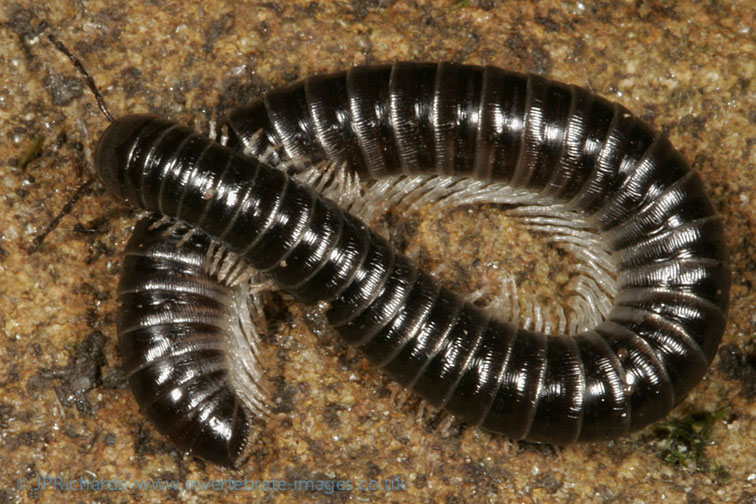Tachypodoiulus niger (Leach, 1814)
Common name
Status:
GB IUCN status: Least Concern
ID Difficulty
Identification
This species is often recognised by its shiny black body, contrasting white legs and a pointed projecting telson. However, in some specimens this colour contrast can be less striking and it can be easily confused with other large species with projecting telsons, such as Julus scandinavius or Ophyiulus pilosus. Immatures are brown, typically with pale longitudinal stripes, and can be confused with Ommatoiulus sabulosus (see image to right).
The presence of traverse striae on the prozonites in addition to the usual longitudinal striae on the metazonites is characteristic of T. niger (and the closely related Ommatoiulus sabulosus).
Distribution
This is one of the most commonly recorded millipedes in Britain and Ireland. It has a very widespread distribution and can attain high population densities in suitable habitat but its high levels of activity account for the frequency with which it is encountered by myriapodologists and the general public alike.
This species has an extended Atlantic distribution in continental Europe where it is found from the Pyrenees north to Germany and east to the Czech Republic (Kime, 1999).
Habitat
Analysis of the habitat data suggests this is an inland rather than a coastal species in contrast to Ommatoiulus sabulosus. A strong association with waste ground is suggested by the analysis but this is another very active animal which could be encountered in almost any habitat.
Kime (2004) reported T. niger to be strongly associated with woodland in Belgium. Although 43% of the British and Irish records were from woodland, analysis of the data did not support the existence of a strong association here. Kime et al. (1992) found that the species was most abundant on limestone but analysis of the recording scheme data provides no evidence of a preference for calcareous soils.
Phenology
Adults can be found throughout the year but are less frequently collected in winter. Animals mature after two or three years (Blower & Fairhurst, 1968) and may survive for several years after first mating. The largest females may be up to nine years old (Blower, 1985). Adult animals readily climb trees and are often collected by entomologists using beating trays.
This species account is based on Lee (2006).
Links
MilliBase - Global catalogue of Millipedes: https://millibase.org/aphia.php?p=taxdetails&id=945433









